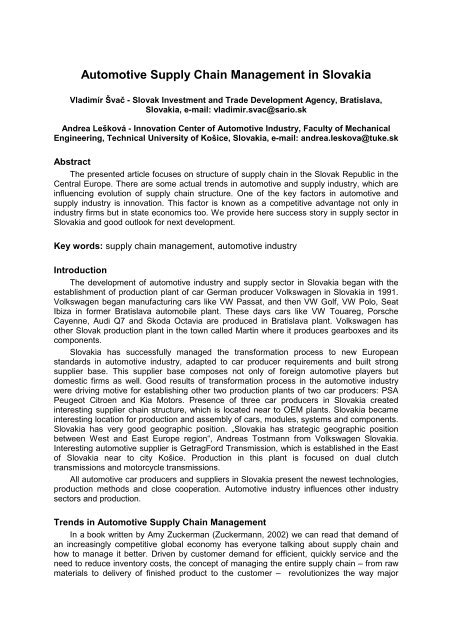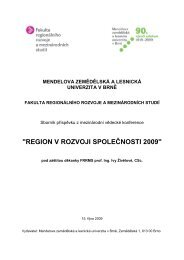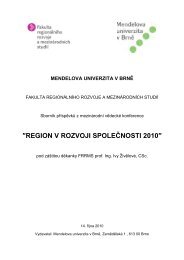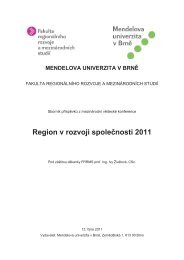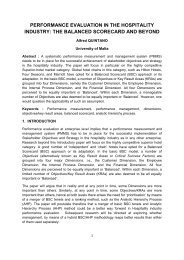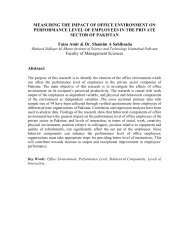Automotive Supply Chain Management In Slovakia - Icabr.com
Automotive Supply Chain Management In Slovakia - Icabr.com
Automotive Supply Chain Management In Slovakia - Icabr.com
Create successful ePaper yourself
Turn your PDF publications into a flip-book with our unique Google optimized e-Paper software.
<strong>Automotive</strong> <strong>Supply</strong> <strong>Chain</strong> <strong>Management</strong> in <strong>Slovakia</strong><br />
Vladimír Švač - Slovak <strong>In</strong>vestment and Trade Development Agency, Bratislava,<br />
<strong>Slovakia</strong>, e-mail: vladimir.svac@sario.sk<br />
Andrea Lešková - <strong>In</strong>novation Center of <strong>Automotive</strong> <strong>In</strong>dustry, Faculty of Mechanical<br />
Engineering, Technical University of Košice, <strong>Slovakia</strong>, e-mail: andrea.leskova@tuke.sk<br />
Abstract<br />
The presented article focuses on structure of supply chain in the Slovak Republic in the<br />
Central Europe. There are some actual trends in automotive and supply industry, which are<br />
influencing evolution of supply chain structure. One of the key factors in automotive and<br />
supply industry is innovation. This factor is known as a <strong>com</strong>petitive advantage not only in<br />
industry firms but in state economics too. We provide here success story in supply sector in<br />
<strong>Slovakia</strong> and good outlook for next development.<br />
Key words: supply chain management, automotive industry<br />
<strong>In</strong>troduction<br />
The development of automotive industry and supply sector in <strong>Slovakia</strong> began with the<br />
establishment of production plant of car German producer Volkswagen in <strong>Slovakia</strong> in 1991.<br />
Volkswagen began manufacturing cars like VW Passat, and then VW Golf, VW Polo, Seat<br />
Ibiza in former Bratislava automobile plant. These days cars like VW Touareg, Porsche<br />
Cayenne, Audi Q7 and Skoda Octavia are produced in Bratislava plant. Volkswagen has<br />
other Slovak production plant in the town called Martin where it produces gearboxes and its<br />
<strong>com</strong>ponents.<br />
<strong>Slovakia</strong> has successfully managed the transformation process to new European<br />
standards in automotive industry, adapted to car producer requirements and built strong<br />
supplier base. This supplier base <strong>com</strong>poses not only of foreign automotive players but<br />
domestic firms as well. Good results of transformation process in the automotive industry<br />
were driving motive for establishing other two production plants of two car producers: PSA<br />
Peugeot Citroen and Kia Motors. Presence of three car producers in <strong>Slovakia</strong> created<br />
interesting supplier chain structure, which is located near to OEM plants. <strong>Slovakia</strong> became<br />
interesting location for production and assembly of cars, modules, systems and <strong>com</strong>ponents.<br />
<strong>Slovakia</strong> has very good geographic position. „<strong>Slovakia</strong> has strategic geographic position<br />
between West and East Europe region“, Andreas Tostmann from Volkswagen <strong>Slovakia</strong>.<br />
<strong>In</strong>teresting automotive supplier is GetragFord Transmission, which is established in the East<br />
of <strong>Slovakia</strong> near to city Košice. Production in this plant is focused on dual clutch<br />
transmissions and motorcycle transmissions.<br />
All automotive car producers and suppliers in <strong>Slovakia</strong> present the newest technologies,<br />
production methods and close cooperation. <strong>Automotive</strong> industry influences other industry<br />
sectors and production.<br />
Trends in <strong>Automotive</strong> <strong>Supply</strong> <strong>Chain</strong> <strong>Management</strong><br />
<strong>In</strong> a book written by Amy Zuckerman (Zuckermann, 2002) we can read that demand of<br />
an increasingly <strong>com</strong>petitive global economy has everyone talking about supply chain and<br />
how to manage it better. Driven by customer demand for efficient, quickly service and the<br />
need to reduce inventory costs, the concept of managing the entire supply chain – from raw<br />
materials to delivery of finished product to the customer – revolutionizes the way major
manufacturers, transporters and logistics <strong>com</strong>panies are doing business. Subsequently, she<br />
writes that <strong>com</strong>panies today cannot ignore supply chain management and expect to survive.<br />
Nowadays, supply chain thinking is <strong>com</strong>mon operating practice for all major <strong>com</strong>panies<br />
worldwide.<br />
<strong>In</strong> yearly publication Auto Annual Report 2008 published by German Verband der<br />
Automobilindustrie are written several interesting remarks about actual trends in automotive<br />
supply industry (VDA, 2008):<br />
• Supplier <strong>com</strong>panies are be<strong>com</strong>ing more important in cooperation between<br />
manufacturers-suppliers and supplier-supplier relationship.<br />
• The changes in the structure of the value-added system lead to a new quality of<br />
cooperation ac<strong>com</strong>panied by altered allocation of roles, increasing challenges due to<br />
a shortage of resources and increased capital needs in the process of globalization.<br />
• Both sides, manufacturers and suppliers, have realized that innovation and premium<br />
quality are the prerequisites for winning customer trust and ensuring market success.<br />
• A major part of automobile development work is now already falling in supply<br />
<strong>com</strong>panies, suppliers will more participate on product design and development and<br />
innovation activities of new products in the future, thus further increasing their share<br />
of added value in the vehicle.<br />
• Flexibility and innovative strength are among the most important <strong>com</strong>petitive<br />
advantages in international business.<br />
A list of global trends is built-up based on research of authors Boghani and Brown<br />
(2000), who divided trends into 5 basic groups:<br />
• Socio-Demographic Trends<br />
• Longer life expectancy – the older driver the more safety features are required<br />
• Changing lifestyle – expecting more than just transportation<br />
• Generation X (young), Y (future) – growing expectations on <strong>com</strong>puters, multimedia<br />
• <strong>In</strong>creasing traffic density – more time spent in vehicles<br />
• Legislative Trends<br />
• <strong>In</strong>crease in regulations globally – fuel economy, environmental factors, safety<br />
• Regional harmonization of legislation<br />
• Technology Trends<br />
• Electronics leading technological advances<br />
• Tremendous explosion in <strong>com</strong>munication and <strong>com</strong>puter technology<br />
• Miniaturization of products<br />
• <strong>In</strong>dustry Trends<br />
• Services emerging as dominating differentiator<br />
• Global acquisition/merger<br />
• Vehicle market mature in Europe and North America, growing elsewhere<br />
• Globalization occurring fast – market, engineering, sourcing<br />
• Shorter product life cycles – reduction in lead times<br />
• New <strong>com</strong>petitors emerging – software, service providers<br />
• Consumer Preference Trends<br />
• Price, quality, performance service and maintenance, safety, <strong>com</strong>fort and<br />
convenience, fuel economy, environment<br />
• Priorities often depend on region
• Subject to change; e.g., global warming may cause that fuel economy and<br />
environment to be<strong>com</strong>e priorities<br />
Wolters and Enders (2001) have own point of view on development trends in automotive:<br />
• Exploiting the opportunities for growth (geographic expansion in the markets in<br />
Eastern Europe, South America, Asia)<br />
• Reducing unit costs and increasing profitability<br />
• Protecting the home markets<br />
• Balancing economic fluctuations and exchange rate risks<br />
• Gaining market share through local production<br />
• Suppliers follow their customers<br />
• Overcapacities and financial risks<br />
Global automotive industry consist of three dominant groups of car manufacturers and<br />
suppliers (Gerhardt, K. (2007):<br />
• Large US-American supplier corporations, who have grown on global scale<br />
alongside the „big three“<br />
• The Japanese suppliers who are tightly integrated into the Japanese keiretsu (it<br />
means „chain“) system.<br />
• Mostly medium-sized German automotive suppliers, who work closely together with<br />
the German car manufacturers<br />
These three groups are presenting three main groups of car producers and their main<br />
global suppliers:<br />
• GM, Ford, Chrysler – Visteon, Delphi, Johnson Controls, Lear, TRW, Goodyear,<br />
DuPont, Arvin Meritor, Dana, Federal Mogul.<br />
• VW, BMW, Mercedes, Audi, Opel, Ford – Bosch, Continental/Siemens VDO,<br />
Schaeffler, Brose, Freudenberg, Behr, Mahle, Benteler, Hella, ZF.<br />
• Toyota, Suzuki, Nissan, Mazda, Honda – Hitachi, Bridgestone, Denso, Matsushita,<br />
Toyoda Gosei, JTEKT, Calsonic Kansei, Sumitomo, Takata, Aisin Seiki.<br />
According to special edition 2008/2009 of German magazine Automobil Produktion<br />
(Global Ranking Top 100 <strong>Automotive</strong> Suppliers 2008), development of global automotive<br />
supplier structure is represented by three dominant world supplier regions (Verlag Moderne<br />
<strong>In</strong>dustry, Automobil Produktion Magazine, 2008): 31 Japanese suppliers, 27 US-suppliers,<br />
25 German suppliers, 6 French suppliers, 3 UK suppliers, 2 Italian suppliers, 1 Canadian<br />
supplier, 1 Swiss supplier, 1 Swedish supplier, 1 Spanish supplier, 1 US/German supplier, 1<br />
US/Swedish supplier.<br />
Consulting <strong>com</strong>pany Oliver Wyman created study named “Car innovation 2015. A<br />
<strong>com</strong>prehensive study on innovation in the automotive industry (2007)”. This study analyzes<br />
the <strong>com</strong>plete framework of automotive innovations: societal and governmental influence,<br />
technology trends, the voice of the customer, innovation economics, innovation management<br />
and strategies. Study brings some results of the Oliver Wyman research. We choose some<br />
of them:<br />
• All auto executives whom Oliver Wyman interviewed in the course of the study were<br />
convinced that innovation was one of the most important success factors for<br />
maintaining a strong <strong>com</strong>petitive position in the auto market.
• Both OEMs and car suppliers do not always meet the needs of the end customer.<br />
Most car drivers want sound, reliable products at reasonable prices. The total cost of<br />
ownership will remain the most important buying factor.<br />
• OEMs and suppliers will have to significantly improve efficiency in all R&D processes<br />
to keep costs under control.<br />
• Cost improvement measures, such as off-shoring of engineering, <strong>com</strong>plexityreduction<br />
programs, standardization and modularization, optimization of new product<br />
development, lean processes or the development of low-cost cars will help the<br />
industry control some of the cost increases produced by the growing number of<br />
functions.<br />
Strong emphasis on innovation and product development is visible in the publication of<br />
Kováč, M. (2007). He says that innovation will be most important factor in the future and<br />
mainly in automotive industry in SMEs. Focus of innovation will be more on eco-innovation,<br />
cost reduction, specific requirements of customers, safety innovation, alternative fuels, ICT<br />
and electronics.<br />
<strong>Supply</strong> <strong>Chain</strong> Structure in <strong>Slovakia</strong><br />
Supplier structure of Slovak automotive environment belongs to the Central Europe<br />
automotive industry with strong connecting to Western European car producers and<br />
suppliers. Czech Republic, Poland and Hungary are next three Central Europe countries<br />
where are established car production plants.<br />
<strong>Slovakia</strong> needed replace fail of heavy industry and armament industry after economic<br />
transformation process. Slovak economic and industry analyzes showed that automotive<br />
industry was only new opportunity for utilization of traditional machinery industry for next<br />
economic development. <strong>Slovakia</strong> offered good conditions for foreign direct investors, mainly<br />
in automotive industry. <strong>In</strong> the present, <strong>Slovakia</strong> is automotive industry country with 1 st place<br />
in the world in 2007 – car production per 1000 inhabitants=105.7 cars. Car production in<br />
<strong>Slovakia</strong> in 2007 was 571 071 cars, car production in <strong>Slovakia</strong> in 2008 was 575 776 cars.<br />
There are more than 75,000 employs in 2007, more than 200 suppliers, good established<br />
local R&D network and universities in <strong>Slovakia</strong>. <strong>Automotive</strong> industry brought on <strong>Slovakia</strong><br />
economic growth, high-tech technologies, new production methods and management of<br />
manufacturing culture in <strong>com</strong>panies, more innovation and increasing of productivity and<br />
quality in all industrials sectors. <strong>Automotive</strong> industry influenced other industry sectors such<br />
as: machinery, chemistry, electronics and electrotechnics, transport, civil engineering and<br />
service development. <strong>Automotive</strong> industry with its supplier sector has key share on total<br />
industry production and it is key industry for growth of the Slovak economy. Slovak<br />
government supports investments into research and development and it emphasis<br />
importance of high-tech and innovation technologies. Here are built modern and high<br />
productive production capacities, quality human resource (availability of technicians,<br />
engineers, researchers and scientists), political stability, Euro currency, innovation policy and<br />
next important factors for foreign investors. On Picture 1 is map of <strong>Slovakia</strong> and locations of<br />
foreign car producers. Slovak supply chain was adapted to conditions and requirements of<br />
three different cultures of car producers (German, French and Korean).
PSA Peugeot Citroen<br />
<strong>Slovakia</strong> in Trnava<br />
Kia Motors <strong>Slovakia</strong><br />
in Zilina<br />
Volkswagen<br />
<strong>Slovakia</strong> in<br />
Bratislava<br />
Pic 1 Map of car producer locations in <strong>Slovakia</strong><br />
Structure of supply chain is <strong>com</strong>posed by 1-Tier, 2-Tier, 3-Tier suppliers and other small<br />
and medium enterprises or organizations and institutes in <strong>Slovakia</strong>. Examples of 1-Tier and<br />
2-Tier suppliers working in <strong>Slovakia</strong> are in next pictures (Pic. 2, Pic. 3). Suppliers are divided<br />
into five basic groups:<br />
• Electrical systems suppliers<br />
• <strong>In</strong>terior equipment suppliers<br />
• Propulsion suppliers<br />
• Body suppliers<br />
• Running gear suppliers<br />
1-Tier SUPPLIERS<br />
Electrical<br />
systems<br />
Cables, bus systems,<br />
embedded systems<br />
Delphi<br />
Kromberg &<br />
Schuster<br />
Leoni<br />
Sewon-Ecs<br />
Sews-E<br />
Siemens<br />
VW Elektricke<br />
systemy<br />
Yazaki<br />
<strong>In</strong>terior<br />
equipment<br />
Cockpit, seats, dashboard,<br />
air conditioning<br />
Faurecia<br />
Grupo Antolin<br />
Hella Behr<br />
Johnson<br />
Controls<br />
Lear<br />
Corporation<br />
Magna-Slovteca<br />
Visteon<br />
Propulsion Body Running<br />
gear<br />
Power train, exhaust<br />
systems, engines<br />
AVC<br />
Faurecia<br />
Getrag Ford<br />
Transmissions<br />
<strong>Slovakia</strong><br />
Matador inalfa<br />
Tower<br />
<strong>Automotive</strong><br />
Body, roof, glass, doors,<br />
lighting etc.<br />
Brose<br />
Dura<br />
Edscha<br />
RF<br />
Hella Slovteca<br />
Magna<br />
Matador inalfa<br />
Plasic Omnium<br />
Suspension, brakes,<br />
axles, steering, tires<br />
Contitech<br />
FTE<br />
Matador<br />
Pic. 2 Scheme of the automotive 1-Tier suppliers in <strong>Slovakia</strong><br />
Source: <strong>Automotive</strong> <strong>In</strong>dustry Association of the Slovak Republic (AIA SR)
2-Tier SUPPLIERS<br />
Electrical<br />
systems<br />
Cables, sensors,<br />
semi conductors, control<br />
units etc.<br />
CRT<br />
Hefra<br />
Küster<br />
Molex<br />
Sluzba VDI<br />
Teleflex<br />
<strong>In</strong>terior<br />
equipment<br />
Cockpit, seats,<br />
dash-board, air<br />
conditioning<br />
Adtool<br />
C.E.P Scherdel<br />
Eismann<br />
Gumotex<br />
Hanil<br />
Heiland<br />
Krasplast<br />
Matador <strong>In</strong>alfa<br />
Technické Sklo<br />
Vural<br />
Propulsion Body Running<br />
gear<br />
Power train,<br />
exhaust systems,<br />
engines<br />
Dana<br />
DOR<br />
Matador <strong>In</strong>alfa<br />
Miba Sinter<br />
Ribe<br />
PFS<br />
Rubena<br />
Sachs<br />
ZF<br />
ZSNP<br />
Body, roof, glass,<br />
doors, lighting etc.<br />
Bourbon Fabi<br />
Gumárne -<br />
Enco<br />
HBPO<br />
SaarGummi<br />
US Steel<br />
Suspension,<br />
brakes, axles, steering,<br />
tires<br />
Continental<br />
Matador<br />
Continental<br />
Teves<br />
Fragokov<br />
Knott<br />
VAP Prešov<br />
T-Gum<br />
Pic. 3 Scheme of the automotive 2-Tier suppliers in <strong>Slovakia</strong><br />
Source: <strong>Automotive</strong> <strong>In</strong>dustry Association of the Slovak Republic (AIA SR)<br />
Jurgens, U. (2003) in his publication writes that engineering services <strong>com</strong>panies play an<br />
increasingly important role in the network of actors involved in new product development.<br />
Most engineering services <strong>com</strong>panies specialize in either product or process engineering,<br />
and in either the propulsion system or the body-interior parts of the car. <strong>In</strong> view of the<br />
shortening of time-to-market requirements and in order to <strong>com</strong>pensate <strong>com</strong>petence gaps of<br />
suppliers, engineering service firms often be<strong>com</strong>e third partners in the cooperation between<br />
suppliers and OEMs for new product development. On Picture 4 we can see old version of<br />
structure of supply chain in <strong>Slovakia</strong>. On Picture 5, we can see new structure of supply chain<br />
in <strong>Slovakia</strong> with new established types of suppliers.<br />
Traditional <strong>Supply</strong> <strong>Chain</strong> in <strong>Slovakia</strong> in 90. years<br />
OEM – Car Producer<br />
1.-Tier<br />
Supplier<br />
1.-Tier<br />
Supplier<br />
1.-Tier<br />
Supplier<br />
2.-Tier<br />
Supplier<br />
2.-Tier<br />
Supplier<br />
2.-Tier<br />
Supplier<br />
2.-Tier<br />
Supplier<br />
3.-Tier<br />
Supplier<br />
3.-Tier<br />
Supplier<br />
3.-Tier<br />
Supplier<br />
3.-Tier<br />
Supplier<br />
3.-Tier<br />
Supplier<br />
3.-Tier<br />
Supplier<br />
3.-Tier<br />
Supplier<br />
Pic. 4 Scheme of traditional supply chain <strong>Slovakia</strong> in 90.years
Traditional <strong>Supply</strong> <strong>Chain</strong> in early 90. years in <strong>Slovakia</strong>:<br />
1-Tier suppliers – foreign <strong>com</strong>panies with own production or assembly capacities<br />
establish near to OEM (mainly global world players)<br />
2-Tier suppliers – foreign <strong>com</strong>panies with own production or assembly plants establish<br />
near to 1-Tier suppliers (global or regional players)<br />
3-Tier Suppliers – local home <strong>com</strong>panies (manufacturing capacities for small simple<br />
automotive parts, raw material suppliers) which fulfil mainly quality and volume conditions of<br />
2-Tier suppliers, some supplies for 1-Tier suppliers.<br />
New Structure of <strong>Supply</strong> <strong>Chain</strong> in <strong>Slovakia</strong><br />
OEM – Car Producers<br />
1-Tier System Supplier<br />
with establishing Local Engineering or<br />
Development Centre<br />
1-Tier System Supplier<br />
with own establishing local production or assembly<br />
and JIT capacities (seat systems, interior systems,<br />
chassis systems, gearbox systems)<br />
2-Tier Supplier<br />
with own establishing local<br />
production or assembly and<br />
JIT capacities<br />
(Module and Component<br />
Supplier)<br />
<strong>In</strong>tegrated<br />
Engineering Service<br />
Supplier (broad range of<br />
services)<br />
Software Service<br />
Supplier (e.g. CAD<br />
systems)<br />
Local R&D and<br />
Scientific <strong>In</strong>stitutions<br />
and Organizations<br />
2-Tier Supplier<br />
with own establishing<br />
Local Development Centre<br />
3-Tier Supplier<br />
(Parts and Component<br />
Supplier, Raw material<br />
Supplier, e.g. plastic parts,<br />
metal parts, aluminum<br />
parts)<br />
AutoCluster (network of<br />
SME, faculties, local R&D<br />
institutions, government<br />
agencies, public bodies and<br />
other)<br />
Consultants<br />
(Project management, TQM,<br />
production systems<br />
optimalization etc.)<br />
Small Engineering Firms and<br />
University departments<br />
Supplier (specialized services,<br />
design, Rapid Prototyping etc.)<br />
Technology<br />
Supplier (e.g. supplier of<br />
automatization, robotics<br />
systems)<br />
Pic. 5 Scheme of new structure of supply chain in <strong>Slovakia</strong><br />
There are various types of suppliers in new structure of supply chain in <strong>Slovakia</strong>. Actual<br />
and the main emphasis are on innovation of product, processes, R&D activities, engineering<br />
services. Suppliers and organizations, which are able to supply services in production<br />
process optimalization, services in cost reduction and engineering services will have strong<br />
<strong>com</strong>petitive advantage in region of Central Europe. One of good example of this emphasis is<br />
universities and its faculties or departments. Chosen services:<br />
• Designing of production processes and systems<br />
• Designing and building R&D Centers and testing laboratories, testing stands<br />
• Study programs prepared according to car producers and suppliers requirements<br />
• Diploma and PhD. thesis<br />
• Research reports, market research<br />
• Rapid Prototyping
• Simple testing activities, experiments<br />
• Car design a car models<br />
Case study of 1-Tier Supplier<br />
Example of successful automotive supplier investor (seat systems supplier) in <strong>Slovakia</strong><br />
is American <strong>com</strong>pany Johnson Controls <strong>In</strong>ternational. 1-Tier System Supplier, Johnson<br />
Controls <strong>In</strong>ternational, has establishing 5 own production and assembly plants in <strong>Slovakia</strong>:<br />
• Plant Lozorno – the main customer is Volkswagen <strong>Slovakia</strong> in Bratislava, production:<br />
car seats assembly in correspondence with Just-in-Time system<br />
• Plant Martin – cover seats production<br />
• Plant Námestovo – the main customers are GM, Daimler, Kia, PSA, production:<br />
plastic parts, door panels for interior, instrument panel assembly<br />
• Plant Žilina – the main customer is Kia Motors <strong>Slovakia</strong>, production: assembly and<br />
JIT deliveries of car seats and interiors: overhead system, door panels, central<br />
consoles<br />
• Plant Lučenec – the main customers are VW (Geel, Zwickau), Renault, Kia Motors<br />
<strong>Slovakia</strong>, production: foam parts injection, seating parts, head rests<br />
• Johnson Controls Bratislava Business Centre - The Business Centre provides<br />
leadership and deliver core business process capabilities in finance, purchasing,<br />
information technology and human resources to support all East European<br />
Customers.<br />
Johnson Controls built one of the biggest technology centers in the Slovak Republic for<br />
developing automotive seats <strong>com</strong>ponents, systems and modules. Opened in 2004 the<br />
130,000 square feet technology center extended the engineering network to include the<br />
Eastern European growth markets and responded to customers’ growing presence there. <strong>In</strong><br />
Trenčin, 500 employees design automotive <strong>com</strong>ponents, systems and modules while using<br />
state-of-the-art technologies and development tools. The technology center houses prototype<br />
facilities as well as product testing capabilities and works closely with Johnson Controls<br />
technology centers in Germany and Johnson Controls customers all over Europe.<br />
US Company Johnson Controls successfully launched cooperation with three technical<br />
universities in <strong>Slovakia</strong>. The first step of cooperation is based on Johnson Controls<br />
promotion and at universities and preparation of diploma thesis for engineering students.<br />
Johnson Controls Engineering Center is looking for the best engineering graduates. Johnson<br />
Controls cooperate on development projects with universities mainly in seat system area. It is<br />
next good step in <strong>com</strong>pany for growth in <strong>Slovakia</strong>. This type of cooperation between 1-Tier<br />
system supplier and universities (or R&D organizations) is key element of building strong<br />
automotive supply chain based on local talents and creating new knowledge.<br />
Conclusions<br />
This success story of foreign supplier evolution in Central Europe gives opportunity for<br />
next growth after financial crisis. Slovak supply chain progress is interesting and excellent.<br />
We can suppose that this evolution of supply chain after financial crisis can brings new<br />
similar success stories of growing building of engineering or technology centers with huge<br />
potential of domestic Slovak research and development environment. By the words of<br />
prominent automotive specialist in <strong>Slovakia</strong>, Mr. Jozef Uhrík (President of <strong>Automotive</strong><br />
<strong>In</strong>dustry Association of the Slovak Republic), we can expect this next development: “<strong>Slovakia</strong><br />
will always have advantage of good geographic location. We need to achieve that Slovak<br />
production plants will be<strong>com</strong>e research-development-production plants. We have managed<br />
production processes in <strong>Slovakia</strong>, but now we must do more. It relates on suppliers, because
supplier will have more participation on product development. There is prediction that in 2015<br />
automotive suppliers will responsible in app.75% for research, development and production<br />
of automotive products and <strong>com</strong>ponents.”<br />
References<br />
Automobil Produktion Magazine. Special Edition 2008/2009. Global Ranking Top 100<br />
<strong>Automotive</strong> Suppliers 2008. Verlag Moderne <strong>In</strong>dustry. Landsberg.<br />
Boghani, A. B. and Brown, A. Jr. (2000). Meeting the Technology <strong>Management</strong><br />
Challenges in the <strong>Automotive</strong> <strong>In</strong>dustry. SAE, Warrendale<br />
Ertlová, E. (2008). Konkurenscieschopnosť zabezpečí výskum a vývoj. (<strong>In</strong>terview with<br />
Mr. Jozef Uhrík, President of the <strong>Automotive</strong> <strong>In</strong>dustry Association of the Slovak Republic). <strong>In</strong>:<br />
<strong>Automotive</strong> <strong>In</strong>dustry Magazine. 3/2008. Žilina, p. 16-18.<br />
http://www.leaderpress.sk/PDF/aimagazine-03.pdf , 25th March 2009.<br />
Gerhardt, K. (2007). Studies on the automotive industry. Germany’s automotive supplier<br />
industry 2018: still dominated by medium-sized enterprises. Frankfurt am Main. Verband der<br />
Automobilindustrie. http://www2.ikb.de/content/en/market_reports/2007/Automobil_engl.pdf ,<br />
24th March 2009.<br />
http://www.johnsoncontrols.sk/publish/us/en/products/automotive_experience/Technolog<br />
y/Technology_Centers/Trencin.html , 24th March 2009.<br />
Jurgens, U. (2003). Characteristics of the European <strong>Automotive</strong> System: Is There<br />
Distinctive European Approach Discussion paper SP III 2003-301 Wissenschaftszentrum<br />
Berlin fur Sozialforschung, http://bibliothek.wzb.eu/pdf/2003/iii03-301.pdf , 24th March 2009<br />
Kováč, M. (2007). Tvorba a riadenie inovácií. Technical University of Košice. Košice<br />
Landmann, R. (ed.) (2001). The Future of the <strong>Automotive</strong> <strong>In</strong>dustry. Challenges and<br />
Concepts for 21st Century. SAE, Warrendale.<br />
Oliver Wyman Consulting Company (2007). Car innovation 2015. A <strong>com</strong>prehensive<br />
study on innovation in the automotive industry.<br />
http://www.oliverwyman.<strong>com</strong>/ow/pdf_files/Car<strong>In</strong>novation2015_engl.pdf, 24th March 2009.<br />
Zuckerman, A. (2002). <strong>Supply</strong> <strong>Chain</strong> <strong>Management</strong>. Capstone Publishing, Oxford.


